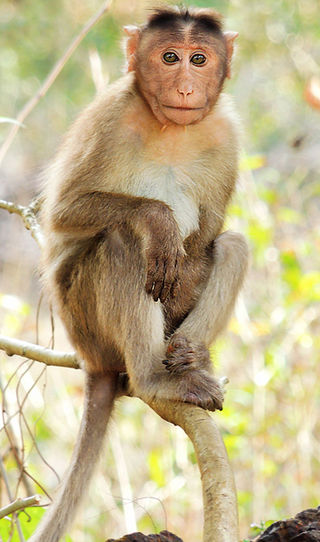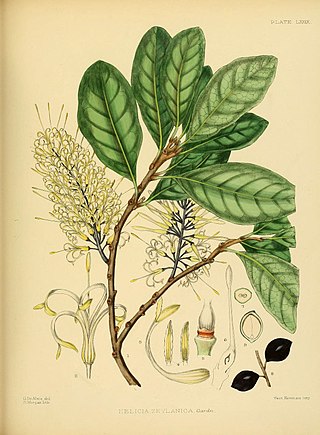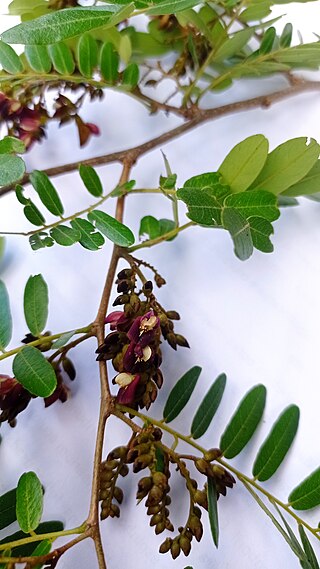
The International Union for Conservation of Nature (IUCN) Red List of Threatened Species, also known as the IUCN Red List or Red Data Book, founded in 1964, is an inventory of the global conservation status and extinction risk of biological species. A series of Regional Red Lists, which assess the risk of extinction to species within a political management unit, are also produced by countries and organizations.

The macaques constitute a genus (Macaca) of gregarious Old World monkeys of the subfamily Cercopithecinae. The 23 species of macaques inhabit ranges throughout Asia, North Africa, and Europe. Macaques are principally frugivorous, although their diet also includes seeds, leaves, flowers, and tree bark. Some species such as the long-tailed macaque will supplement their diets with small amounts of meat from shellfish, insects, and small mammals. On average, a southern pig-tailed macaque in Malaysia eats about 70 large rats each year. All macaque social groups are arranged around dominant matriarchs.

Rosewood is any of a number of richly hued hardwoods, often brownish with darker veining, but found in other colours. It is hard, tough, strong, and dense. True rosewoods come from trees of the genus Dalbergia, but other woods are often called rosewood. Rosewood takes a high polish and is used for luxury furniture-making, flooring, musical instruments, and turnery.

Morpho peleides, the Peleides blue morpho, common morpho or the emperor is an iridescent tropical butterfly found in Mexico, Central America, northern South America, Paraguay and Trinidad. Most authorities believe that peleides is a subspecies of Morpho helenor.

An IUCN Red List Critically Endangered species is one that has been categorized by the International Union for Conservation of Nature as facing an extremely high risk of extinction in the wild. As of December 2023, of the 157,190 species currently on the IUCN Red List, 9,760 of those are listed as Critically Endangered, with 1,302 being possibly extinct and 67 possibly extinct in the wild.

Dalbergia nigra, commonly known as the Bahia rosewood, jacarandá-da-Bahia, Brazilian rosewood, Rio rosewood, jacarandá-do-brasil, pianowood, caviúna, graúna, jacarandá-una or obuina is a species of legume in the family Fabaceae.

Machaerium is a genus of flowering plants in the family Fabaceae, and was recently assigned to the informal monophyletic Dalbergia clade of the Dalbergieae. It contains the following species:
Machaerium cirrhiferum, the espuela de gallo or espuela de gato, is a species of flowering plant in the family Fabaceae. It is found in Colombia, Costa Rica, Mexico, and Panama.
Machaerium cuzcoense is a species of flowering plant in the family Fabaceae. It is found only in Peru.
Machaerium glabripes is a species of flowering plant in the family Fabaceae. It is found only in Panama.

Machaerium villosum, the jacarandá-do-cerrado, jacarandá-pardo, jacarandá-paulista, or jacarandá-pedra, is a native tree belonging to the Fabaceae family, primarily in Brazil. These trees preferably grown on the Cerrado and Caatinga, but they can also inhabit the Atlantic Forest. They are currently vulnerable due to logging and, primarily, habitat loss for agriculture and livestock.

Satakentia liukiuensis, is a species of palm tree. They are endemic to Ishigaki Island and Iriomote Island in the Yaeyama Islands, the south-westernmost of the Ryukyu Islands, Japan. It is the only species in the genus Satakentia.
Tectiphiala ferox, or palmiste bouglé, is a species of flowering plant in the family Arecaceae. It is endemic to Mauritius.
Espuela de gallo is a common name for several plants and may refer to:

Helicia is a genus of 110 species of trees and shrubs, constituting part of the plant family Proteaceae. They grow naturally in rainforests throughout tropical South and Southeast Asia, including India, Sri Lanka, Indochina, Peninsular Malaysia to New Guinea and as far south as New South Wales.

Ocotea porosa, commonly called imbuia or Brazilian walnut, is a species of plant in the Lauraceae family. Its wood is very hard, and it is a major commercial timber species in Brazil.
Terminalia ivorensis is a species of tree in the family Combretaceae, and is known by the common names of Ivory Coast almond, idigbo, black afara, framire and emeri.
Pau ferro is a common name for several trees and may refer to:

The Guianan piedmont and lowland moist forests (NT0182) is an ecoregion in the south of Venezuela and the north of Brazil. It is in the Amazon biome. The ecoregion is relatively intact, largely protected by conservation units or indigenous territories, and less threatened by global warming than flatter and more deforested regions.

Machaerium scleroxylon is a species of tree in the family Fabaceae Common names for the species include: pau ferro, morado, caviuna, Bolivian rosewood, and Santos rosewood. The wood is used as an alternative species to genuine rosewoods belonging to the genus Dalbergia.













